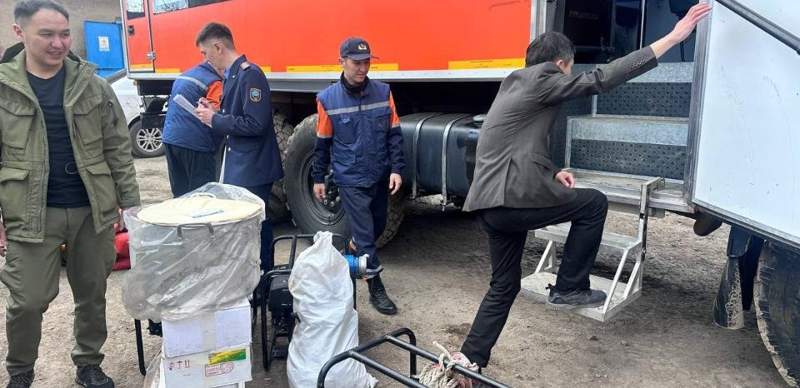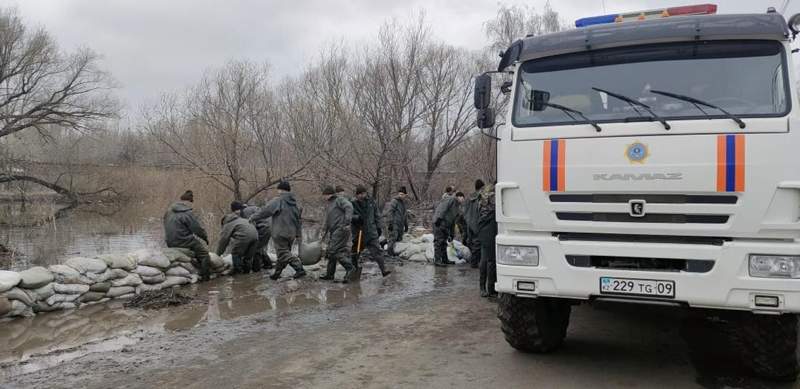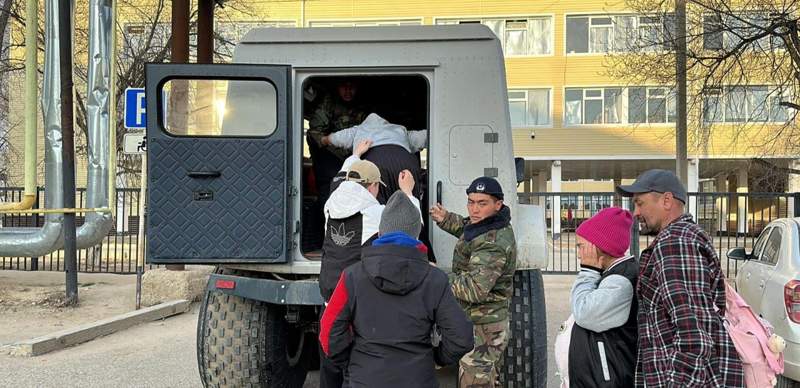Latest update on floods in Kazakhstan as nation remains underwater

Despite the efforts of the authorities and rescue services, the situation with floods in Kazakhstan remains critical as water levels continue to rise, Kazinform news agency correspondent reports.
According to the latest update from the Ministry of Emergency Situations, more than 76,000 people have been rescued since the flood began, more than 18,000 of whom were children. Evacuating the population to safe places and creating temporary living centers for those who find themselves homeless are important aspects of providing assistance. Psychologists provide emergency psychological assistance to victims through the hotline.
The condition of rivers and reservoirs is continuously monitored through aerial surveys and drone use. In regions where increased danger is detected, blasting work is carried out to prevent ice jams, as was carried out on several rivers in the North Kazakhstan and Kostanai regions.
At the same time, operations to eliminate the consequences of floods continue. More than 7 million cubic meters of meltwater were pumped out, and a huge amount of work was carried out to strengthen the banks, lay bags and other flood control measures.
The Ministry of Culture and Information of Kazakhstan reported that volunteers continue to be active in various regions of Kazakhstan, helping flood victims. In the regions of Aktobe, Kostanai, West Kazakhstan, Akmola, Atyrau and the Abai, they work at evacuation points, strengthen coastlines and assist in collecting humanitarian aid.

Nearly 25,000 volunteers are involved in the regions. More than 553.4 tons of humanitarian aid have been collected, including more than 370 tons already delivered to the regions.
In the Aktobe region, 8,500 volunteers work around the clock to collect humanitarian aid and organize its delivery. Volunteers are also involved in other regions. In the Akmola region, assistance was provided to 700 people. In the West Kazakhstan region, there are more than 4,000 volunteers, and in the Kostanai region - about 3,000. A single contact center operates to coordinate assistance and distribute volunteers, reported the ministry.
According to information provided by the emergency situations departments of the Ulytau and Pavlodar regions, emergency teams from various regions mobilized aid in response to the flood situation in the North Kazakhstan region.

The emergency department of the Ulytau region dispatched 33 personnel, 4 units of equipment, 4 motor pumps, and 3 floating vessels to Petropavlovsk. 53 personnel, 10 units of equipment, and watercraft were sent from Pavlodar.
Additionally, the Karaganda region deployed 70 emergency personnel, 11 units of equipment, 6 watercraft, and 27 water pumping units. These teams will conduct rescue and flood control operations, including pumping out water, constructing trenches, and fortifying dams. Overall, a total of 156 personnel and significant equipment were mobilized for assistance.
“The rescuers have not yet reached their destination. They will provide the necessary assistance in flood-prone areas of the region. They will pump out melt water, lay trenches, prepare bags and strengthen dams,” reads the statement of the Emergency Situations Department of the Karaganda region.

During the flood period, the Ministry of Emergency Situations urges citizens to be extremely careful and strictly observe safety measures.
“Stay in houses and evacuation centers only with the permission of rescue services. When receiving a signal of danger, it is necessary to warn neighbors and provide assistance to people with disabilities and children, following the instructions. Prepare the necessary supplies in advance: clothing, food, and medicine, and store them in waterproof bags. Disconnect all electrical consumers, turn off the gas, extinguish the fire in the stoves, and carefully close windows and doors to minimize the risk of fire and water entering the room,” says the ministry.
The official representative of the Ministry of Water Resources and Irrigation, Moldir Abdualieva, reported on April 8 that the ministry is currently focusing its main efforts on ensuring the safety of hydraulic structures and reservoirs to regulate river flow and prevent floods. In connection with the formation of flood flow on the Tobol and Zhaiyk rivers, the ministry is actively exchanging hydrological data with the Russian Federal Service for Hydrometeorology and Environmental Monitoring, also known as Rosgidromet.
The average filling of two large reservoirs in the Aktobe region also stands at 99%, the facilities are operating in transit mode, a decrease in water inflow is observed. The peak of the spring flood has also passed.
In the East Kazakhstan region, the average filling of five large reservoirs is 62%, and all of them are operating normally. The peak of the flood is expected this week.
In the West Kazakhstan region, four large reservoirs are filled, on average, to 65% and are operating normally. The level of the Chagan river continues to rise, and as of today, the inflow into the Chagan reservoir is 690 cubic meters per second.
In the Kostanai region, the average filling of two reservoirs is 96%, and flooding is observed. The tense situation in the Karatomar reservoir continues. All sites are monitored around the clock.

In addition, the ministry initiated the creation of a national hydrogeological service to monitor the use of groundwater resources.
Earlier today, President Kassym-Jomart Tokayev spoke with the governors of the Akmola, Aktobe, Kostanai, and North Kazakhstan regions by phone. They reported on the situation and measures taken to curb the flood. Under Tokayev’s directive, vice ministers were sent to the affected regions to provide assistance.
Foreign leaders continue to express support for Kazakhstan in this challenging period.
The Turkish Foreign Ministry said on April 7 that the country stands in solidarity with the people and government of Kazakhstan. Azerbaijan also expressed support.
The Kyrgyz Republic sent 300 tons of humanitarian aid to Kazakhstan. Tokayev thanked his Kyrgyz counterpart, Sadyr Zhaparov, for the support.
Ryszard Czarnecki, member of the European Parliament from Poland, also expressed his support to the people of Kazakhstan.

